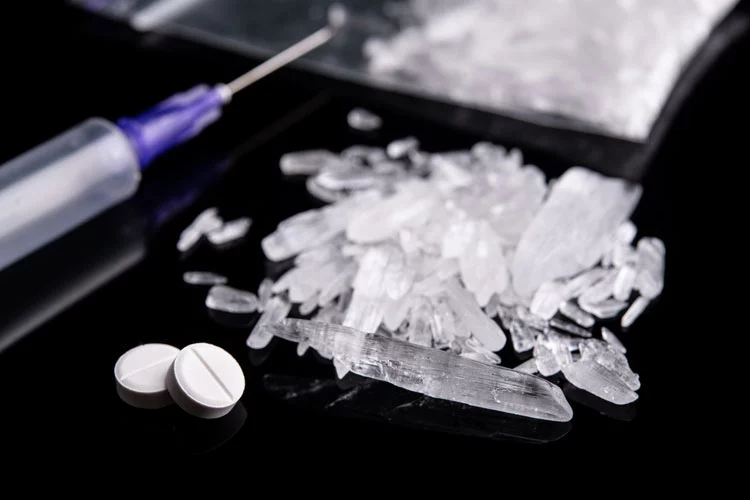Outpatient Meth Rehab Near You

After years of abusing meth and other stimulants, significant changes occur within the mind. This drug changes the way a person thinks, acts, makes decisions, and even their perception of reality. Finding the right outpatient meth rehab can be crucial to gaining back control of your life.
Meth doesn’t cause the same physical dependence as opioids. It doesn’t cause the same type of neurological damage as long-term cocaine abuse.
However, the combination of the strain on the mind and body creates a one-two punch that other drugs don’t deliver during detoxification. The physical and mental withdrawal symptoms of meth may not be the most severe on their own – but when they’re combined, it creates pain and discomfort in the mind and body that’s enough to bring even the toughest person to their knees.
How does this highly addictive drug accomplish this, and why haven’t we heard more about it? In the next section, we’ll outline what meth is exactly, and how it affects the body and mind.
What Is Meth?
Methamphetamine is a drug that falls into the stimulant class, causing increased periods of alertness, extreme energy, euphoria, and an inflated sense of importance. However, in large doses or consecutive abuse for days on end, meth can cause paranoia, anxiety, and in extreme cases, psychosis.
Crystal meth is unique in the way that it’s manufactured for the eventual sale on the black market. This drug doesn’t come from a natural source like opiates and cocaine, two other commonly abused drugs that battle with meth for the top three most abused drugs in the United States
This insidious narcotic is 100% synthetic, much like fentanyl or methadone. However, what makes meth so scary are the ingredients used to formulate the final product and the fact that it can be made by the average user with the right amount of chemistry know-how.

The Evolution of Meth Manufacturing
America had a huge problem in the 90s with a very crudely manufactured, highly impure version of the drug known as crank. Batches of crank were manufactured in garages, sheds, campers, and kitchens all around the country (but mostly in the Midwest and the South).
The primary ingredients sounded like items you’d find in a janitor’s closet, not a list of ingredients for a street drug: Drain-O, lithium from batteries, antifreeze, and other deadly products were blended to create this highly dangerous form of meth.
After a decade-long battle with this issue, the DEA finally began cracking down on clandestine meth labs. The driving factor was the number of explosions that took place because of the crude manufacturing process and volatile list of ingredients.
Methamphetamine production and use went way down, but this would only be a short-lived victory for law enforcement. Waiting in the wings were the Mexican drug cartels, quick to capitalize on the high demand these arrests and raids created on the black market.
The Rise of Super Meth
What ended up emerging was a highly pure, super-potent version of methamphetamine that took the country by storm. While simultaneously dealing with the opioid pill epidemic and the subsequent heroin and fentanyl epidemics, methamphetamine slowly became the number two most abused drug in the United States.
Currently, the battle against meth abuse rages on, as many rehab centers fill with users entering treatment for the combination of meth and heroin abuse. Because of the versatile ingredient list and the way meth is manufactured, this drug wreaks havoc on the mind and body.
Normally, most of the focus is on the mental aspect because of the potential for meth-induced psychosis. However, there is a genuine concern regarding the physical effects of meth.
How Does Meth Affect the Body?
Meth has a significant effect on the body, causing significant challenges in multiple areas of the anatomy. Let’s look at the different ways meth can wreak havoc on a user’s body.
Muscles
One of the most significant physical side effects of meth takes place within the muscular system. When users engage in meth abuse, they commonly tighten all the muscles of the body in a clenching manner.
The end result of this incredible strain on the body is long-term damage from pulled and torn muscles. Additionally, it’s not uncommon for users to suffer from incredibly severe hernias because of the intense, constant flexing after what can sometimes be multiple days without sleep.
Heart/Blood pressure

One of the main side effects of short-term meth use is an incredibly fast heart rate and a spike in blood pressure. However, after years of abuse, the problems don’t remain short-term and eventually have the potential to graduate into chronic conditions.
It’s not uncommon for long-term meth users to develop heart disease, have complications from heart attacks, and other challenges with the cardiovascular system. Users who abuse meth in IV form also have issues with blood clots.
Weight Loss/Malnourishment
One condition that isn’t commonly considered is the devastating weight loss many users of crystal meth experience. After days of remaining high on the drug, most users will forget to eat, leading to significant weight loss and challenges associated with malnourishment.
Challenges from a lack of essential vitamins and minerals can lead to a loss of teeth, hair, bone density, and fingernails.
The good news is that most of these conditions are reversible with long-term abstinence from meth abuse disorder. Many users experience a full recovery after participating in outpatient meth treatment.
Choosing Outpatient Meth Treatment
Because meth doesn’t bring the crippling side effects of opiates during the withdrawal process, meth users are suitable candidates for outpatient rehab. This doesn’t mean that the process is easy, but it’s certainly more manageable with the right treatment plan and support systems.
Additionally, with the right medication-assisted treatment and diet plan, it’s possible for individuals in outpatient treatment to remain in a condition to continue working. In fact, occupying your time with long activities like work can be healthy and prevent relapse during the treatment period and aftercare phase.
Users will have to decide on inpatient treatment versus outpatient treatment. It’s important to weigh your options carefully and make the decision that’s going to promote the best possible outcome.
Inpatient vs. Outpatient Meth Treatment
Each form of meth treatment has its own set of pros and cons. One of the most significant factors in the final decision will be the severity of the user’s physical dependence on the drug.
While meth doesn’t bring the painful physical withdrawal that opioids deliver, years of relying on a stimulant to push your body to the brink can present some serious challenges. Additionally, it’s important to keep a positive mindset and remain proactive in the conscious effort to say no to using.
If you have questions about your willpower or support system, inpatient treatment might be more suitable. However, if you have loved ones in the home that share your goal of recovery and you’re confident about your level of willpower, outpatient treatment could be more advantageous.
When you’re in the decision-making stage of the treatment process, it helps dramatically to have a firm understanding of how outpatient meth rehab works. The following section provides a potential outline of outpatient meth treatment.
How Outpatient Meth Rehab Works
During outpatient rehab, users will participate in 10 to 20 hours per week of in-person counseling and treatment services. In treatment, mental health professionals offer their services for several different types of behavioral treatment, trauma-based treatment, and dual-diagnosis treatment if the potential for an underlying mental health disorder is present.
12-step recovery treatment models complement the one-on-one time with counselors and allow you to gain insight and share inspiration with peers. Family counseling services will also allow loved ones to become involved to remedy damaged relationships inside the home.

Structured Support for Meth Recovery
During outpatient rehab, there are also more private options available for users who need discreet services. These are catered towards members of the corporate or business world and include options for late evening meetings, as well as other benefits to ensure 100% privacy.
Medication-assisted treatment is also an option during outpatient rehab treatment. This provides relief from the discomfort of meth withdrawals.
Many people assume that meth withdrawal doesn’t exist, but this couldn’t be further from the truth. Meth withdrawals present themselves in a different manner than opiates, but that doesn’t mean they don’t exist.
Does Meth Cause Withdrawals?
Meth causes withdrawals of the mental form and not so much physical. The user will experience certain physical symptoms, but this is mostly just the body rebounding from fatigue and relying on a stimulant to overwork itself.
A few days of soreness and fatigue usually lead to the most intense physical symptoms subsiding. However, mental challenges may persist for months after abstinence is achieved.
Meth use causes extreme paranoia and changes the way users perceive everything around them. Because of this, the user’s brain is completely rewired, and the mental aspect of withdrawal can be quite intense.
The need for high-level care for mental health challenges during withdrawal and treatment is critical to assist users in a normalized way of thinking. Listed below are some of the most significant challenges caused by the side effects of meth withdrawal.
Common Meth Withdrawal Symptoms
Some of the most commonly experienced meth withdrawal symptoms include:
- Extreme periods of paranoia and anxiety
- Extreme fatigue
- Difficulty concentrating
- Scattered thoughts
- Problems with social interactions
- Dizziness, vertigo
- Sweating
- Hot flashes
At Discovery Transitions Outpatient, we believe long-term recovery from meth is possible with the right individual treatment plan, education regarding your substance abuse disorder, and a strong support system outside of treatment.
Having the right team once you begin addiction therapy in Los Angeles is the first important step. You’ll receive a personalized treatment plan with attention from multiple counselors. This ensures that 100% attention and effort are placed on your recovery.
Discovery Transitions Outpatient for a Better Life
With the help of our clinical team and treatment professionals, having the goal of long-term recovery doesn’t have to be far-fetched. We’ll help you get to the core of your substance use disorder issues, meth or otherwise, and help you prepare by providing aftercare resources and pointing you in the right direction to maintain recovery.
Finally, we’ll show you how to create and maintain a strong support system, which will end up being your most valuable tool after treatment. When you’re ready to start your journey toward recovery, contact one of our Admissions specialists and let them know you’re ready to get serious about sobriety.


 Call
Call Text
Text